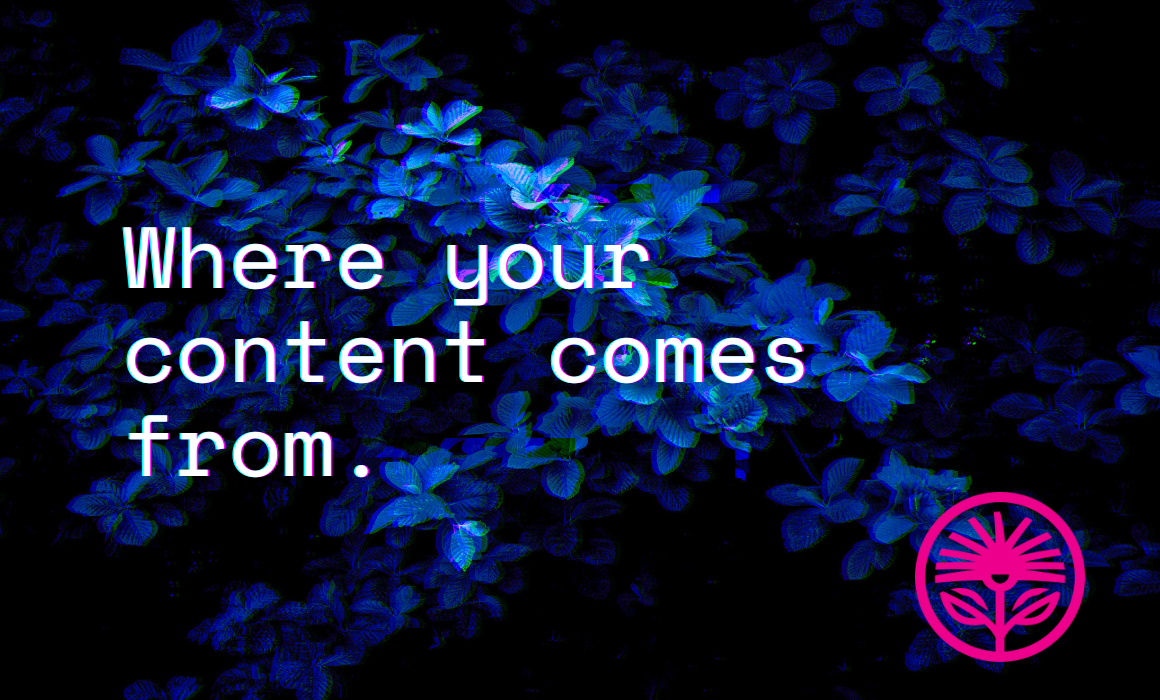Where does content come from? — Kelford Labs Weekly
And how to get it noticed.

If I had to sum up the vast majority of questions I’ve been asked and have answered over the years, it would all boil down to:
“What should I say, and where should I say it?”
That’s, like, the problem, right? And it sounds so simple, too.
You already know that marketing can work, and to some extent your marketing probably already does. But you know it can improve, that there’s a more efficient, more effective path, if only you could find it.
But, of course, in a world full of infinite options and ideas, the issue becomes selection.
“Try a bunch of things and see what works” ends up being the standard advice, but it kind of ignores the fact that you can try a lot of things and have none of them work.
Because there are just too many things to try, and too many places in which to try them.
So the real problem becomes the uncertainty about which ideas to try, and where to try them.
That’s no small question to try to answer, and over the years I’ve spent a lot of time and energy thinking of the right way to answer it for any particular entrepreneur.
Lately, I’ve found asking the three questions below is a great way to get started toward that answer.
So, if you’ve ever wondered what to say and where to say it, I’d invite you to ask yourself these questions, too:
1) Where would your current best client see your marketing?
The idea here is, it’s usually best to be led to your next best client nearby, rather than search for them somewhere out there, in the confusing distance, far away from your business.
The mistake we can easily make is best described by that William Gibson quote, from his book Idoru: “It’s easier to desire and pursue the attention of tens of millions of total strangers than it is to accept the love and loyalty of the people closest to us.”
Right? When we think about the people we want our marketing to reach, how often is it the prospects we can actually reach, and how often is it the prospect we wish would notice us?
But the somewhat painful fact is that the people who already know us and the people who already want what we sell are the people most likely to buy from us.
So why wouldn’t we talk to them first, and then grow toward that more distant ideal?
Ask yourself: If you wanted to place a marketing message somewhere that your current best client would see it, where would you put it?
Would they see that golf tournament sponsorship you’re considering? Your new TikTok or YouTube account? Would they see your latest LinkedIn post? Your recent blog or newsletter?
The lesson is, if your current best clients wouldn’t see your marketing, chances are your ideal next client won’t, either.
2) What do you have unlimited ideas for?
Tell me something: What part of your work can you talk about forever?
I know there’s something, you know there’s something. The idea is to find it and tap into it.
Because anyone can create a handful of decent marketing or content topics once, but it takes real curiosity and motivation to have ideas constantly.
And that’s a huge part of the game, now. We’ve got to be able to demonstrate as experts that we have some advantage over ChatGPT, that we know more than random TikTokers. Otherwise, why would they believe us, let alone pay us, to help them when those alternatives exist?
That means orbiting our marketing efforts around something we have endless energy to learn about, think about, and talk about.
That’s why, in my “Novel Token Sessions” with clients, I work hard to find the areas where they have unlimited ideas and energy. Where they can talk endlessly, and where they have a real interest and intrinsic motivation to improve.
So what do you think about, when it comes to your work, all the time? Where have you focused your energy and education? What have other people, like your colleagues, friends, and family told you they’ve noticed you can talk endlessly about?
Getting started is so much easier when you have intrinsic motivation, and sustaining that is easier when you have unlimited inspiration.
3) What do you have current capabilities for?
I’ve seen a lot of marketing plans that were actually wishlists.
Because they assumed more resources, more time, or more energy than they actually had.
Sure, great ideas can be inspiring, motivating, and energizing. For a time.
But then once we’re actually in it, we can actually realize we’d overcommitted ourselves, our team, or our budgets to something that’s going to take a bit longer than we’d imagined.
So take a moment to think about what kind of marketing or content commitments you and your team are capable of taking on, right now, today, with what you have on hand. Yes, marketing is an investment and it involves a bit of risk, but it investments take patience, too. Everything else is a gamble.
So what can you do, right now, with what you have?
For some of my clients, it’s 30 minutes every couple of weeks to hop on a call so I can extract a bunch more novel insights, about the things they can talk endlessly about, focused on what their current best clients care most about. But because it’s new, it’s fresh, and it’s connected to the real world, it can fuel their marketing.
The idea is to lean into areas you have existing resources and energy for, so you can narrow the realm of possible options for what to say and where to say it to just the ones you can start and stick to.
So, did these questions help you answer the bigger question of what to say, and where to say it?
Remember, it can all be summed up simply as:
If you want to narrow your possible marketing options down to what you can be noticed for, what you can get better at, and what you can stick to, start by:
- Identifying where your current clients would see your marketing content, and how you can get the attention of clients like them there.
- Tapping into your endless sources of inspiration, and thinking of marketing and content ideas that you’ll want to keep trying and learning from.
- Creating marketing messages and content based on those ideas, with the resources you currently have access to, so you can learn where to invest more heavily based on performance.
The truth is, “What do I say, and where do I say it?” is a big question.
But finding the answer can start small.
And it can start today.
If you’d like support finding what to say, and where to say it, sign up for our Marketing Rangefinder workshop.
Kelford Inc. shows you the way to always knowing what to say.



